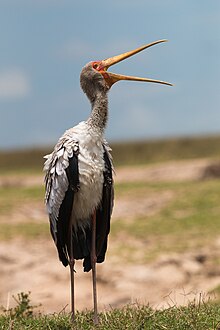Yellow-billed stork
| Yellow-billed stork | |
|---|---|
 |
|
| At Maasai Mara National Reserve | |
| Scientific classification | |
| Kingdom: | Animalia |
| Phylum: | Chordata |
| Class: | Aves |
| Order: | Ciconiiformes |
| Family: | Ciconiidae |
| Genus: | Mycteria |
| Species: | M. ibis |
| Binomial name | |
|
Mycteria ibis (Linnaeus, 1766) |
|
The Yellow-billed stork (Mycteria ibis), sometimes also called the wood stork or wood ibis, is a large African wading stork species in the family Ciconiidae. It is widespread in regions south of the Sahara and also occurs in Madagascar.
The yellow-billed stork is closely related to 3 other species in the Mycteria genus: the American woodstork (Mycteria americana), the milky stork (Mycteria cinerea) and the painted stork (Mycteria leucocephala). It is classified as belonging to one clade with these 3 other species because they all display remarkable homologies in behavior and morphology. In one analytical study of feeding and courtship behaviours of the wood-stork family, MP Kahl attributed the same general ethology to all members of the Mycteria genus, with few species-specific variations. These four species are collectively referred to as the wood-storks, which should not be confused with one alternative common name (wood-stork) for the yellow-billed stork.
Before it was established that the yellow-billed stork was closely related to the American woodstork, the former was classified as belonging to the genus Ibis, together with the milky stork and painted stork. However, the yellow-billed stork has actually long been recognised as a true stork and along with the other 3 related stork species, it should not strictly be called an ibis.
It is a medium-sized stork standing 90–105 cm (35–41 in) tall. The body is white with a short black tail that is glossed green and purple when freshly moulted. The bill is deep yellow, slightly decurved at the end and has a rounder cross-section than in other stork species outside the Mycteria. Feathers extend onto the head and neck just behind the eyes, with the face and forehead being covered by deep red skin. Both sexes are similar in appearance, but the male is larger and has a slightly longer heavier bill. Males and females weigh approximately 2.3 kg (5.1 lb) and 1.9 kg (4.2 lb) respectively.
...
Wikipedia

